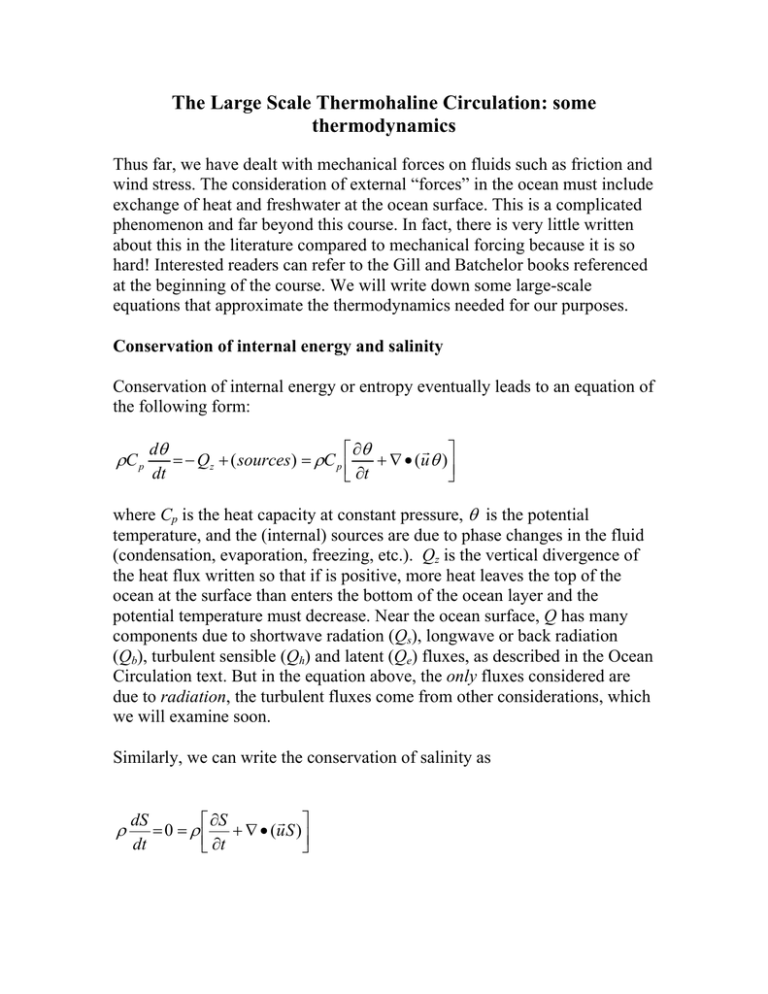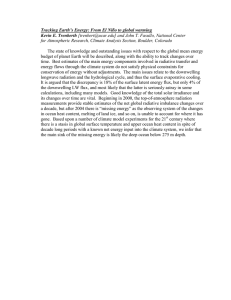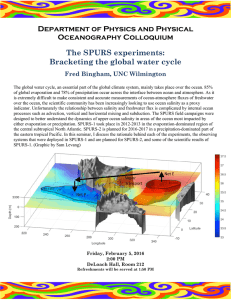The Large Scale Thermohaline Circulation: some thermodynamics
advertisement

The Large Scale Thermohaline Circulation: some thermodynamics Thus far, we have dealt with mechanical forces on fluids such as friction and wind stress. The consideration of external “forces” in the ocean must include exchange of heat and freshwater at the ocean surface. This is a complicated phenomenon and far beyond this course. In fact, there is very little written about this in the literature compared to mechanical forcing because it is so hard! Interested readers can refer to the Gill and Batchelor books referenced at the beginning of the course. We will write down some large-scale equations that approximate the thermodynamics needed for our purposes. Conservation of internal energy and salinity Conservation of internal energy or entropy eventually leads to an equation of the following form: ρC p G dθ ∂θ = − Qz + ( sources ) = ρC p + ∇ • (u θ ) dt ∂t where Cp is the heat capacity at constant pressure, θ is the potential temperature, and the (internal) sources are due to phase changes in the fluid (condensation, evaporation, freezing, etc.). Qz is the vertical divergence of the heat flux written so that if is positive, more heat leaves the top of the ocean at the surface than enters the bottom of the ocean layer and the potential temperature must decrease. Near the ocean surface, Q has many components due to shortwave radation (Qs), longwave or back radiation (Qb), turbulent sensible (Qh) and latent (Qe) fluxes, as described in the Ocean Circulation text. But in the equation above, the only fluxes considered are due to radiation, the turbulent fluxes come from other considerations, which we will examine soon. Similarly, we can write the conservation of salinity as ρ G dS ∂S = 0 = ρ + ∇ • (u S ) dt ∂t This looks deceptively simple for salinity until we realize that at the ocean surface, there is a net velocity because of an imbalance between Precipitation, P, and Evaporation, E. A positive vertical velocity is one in which the sea surface is moving upwards because of a net freshwater addition: thus at the free surface, w = (P-E). As we will soon see, the salinity flux at the free surface is given by -(P-E)S. Consider a column of fluid extending from the free surface to the ocean bottom. If we integrate the potential temperature and salinity equations in this fluid column, we will get the following expressions: h ∫ dzρC p −H h ∂S ∫ dzρ ∂t ∂θ h h = Qv + Qe − ρC p wθ ]− H − Q ]− H ∂t = Sv − ρw S ]− H , where χ ]− H ≡ χ ( z = h ) − χ ( z = − H ) h h −H We have lumped for the moment all of the divergences due to horizontal flows into a couple of terms, Qv and Sv. [we will return to these later, don’t worry!] We have also explicitly written down an internal heat source term depending on the evaporation. Ignoring the heat flux through the ocean bottom due to geothermal heating: Q(z=-H) and writing the vertical velocity, potential temperature and salinity in two parts: w=<w>+w’, etc., where the brackets refer to the “average” property and the prime represents the fluctuations, the above can be re-written: h ∫ dzρC −H h ∫ dzρ −H p ∂ <θ > h =< Qv > + < Qe > −ρCp < w'θ ' ( z = h) > −ρCp < w >< θ >]−H − < Q( z = h) > ∂t ∂<S> h =< Sv > −ρ < w' S' ( z = h) > −ρ < w >< S >]−H ∂t In the above we have ignored small spatial variations of density and heat capacity and considered only the balance for the <average> quantities. Turbulent fluxes or heat will produce an average product <w’θ’> that is non-zero; this need not be the case for salinity because salt is not transferred across the air-sea boundary [we will ignore this <w’S’> term]. We can define the turbulent sensible heat flux as <Qh> ≡ -ρCp<w’θ’> and if we now write out the two individual radiation terms (dropping the <brackets> notation around <Q> ) we obtain: h ∫ dzρC p −H h ∫ dzρ −H ∂ <θ > h = Qs + Qb + Qv + Qh + Qe − ρC p < w >< θ >]− H ∂t ∂<S> h = Sv − ρ < w >< S >]− H ∂t where we have followed the sign convention that a positive heat flux is one which is into the ocean. In a moment we will write down the horizontal flux terms, but look at the first equation above: it contains terms that represent heat and salinity transfer that depend on the average vertical velocity at the boundaries. These can be eliminated using the following identities: ∂<h> ∂<h> ∂<h> = P − E; + < u( z = h ) > + < v( z = h ) > ∂y ∂t ∂x ∂H ∂H < w( z = − H ) >=< u ( z = − H ) > + < v( z = − H ) > ∂x ∂y < w( z = h ) >= If we take the time and space derivatives in the salinity and temperature budget equations outside the integral and use the above, we can get a simplified pair of equations for the vertically-integrated potential temperature and salinity: ∂ ∂t <h > ∂ ∂t <h > ∫ dzρC p < θ >= Qs + Qb + Q 'v + Qh + Qe , where Q 'v = −∇ h • −H ∫ dzρ < S >= S ' −H <h> ∫ dz ρC p G (< u >< θ > ) −H <h> v = −∇h ∫ −H G dz ρ (< u >< S > ) ≈ − ρ S0 ( P − E ) − ∇ h • <h> G ∫ dz ρ (< u >< S >), −H where S = S0 + S The quantities on the left hand sides of the above two equations are the heat and salt content of water column where locally there may be a non-zero “average” vertical velocity at the free surface (due to P-E) and bottom. The salinity equation does not show a (P-E) term at the surface, but remember that the integration is from the bottom to the top of the ocean and that the upper surface may not be steady or even if it is, there will be divergence in the horizontal volume flux (contained in Sv’) that is required to balance (P-E) at the surface. We have rewritten this equation in terms of (PE) by defining a global average salinity, S0 and relating the horizontal divergence of the volume transport to (P-E) at the surface. The salinity balance is very sensitive to ocean advection: there being no other terms that force it! It is the salinity balance that is used to estimate the freshwater transport of the ocean in climate calculations. We could have been fancier and also derived horizontal eddy flux terms (proportional to <u’θ’>, <u’S’>) for heat and salt, but this would not materially add to the above material since this argument is similar to the vertical eddy flux discussion just presented. This decomposition into smallscale, random fluctuations and an ensemble average state lies at the very heart of eddies & parameterization of turbulence. Also, we might mention that one can consider areas of rainfall as adding volume (or mass) to the ocean surface at one temperature, and areas of evaporation as areas of decreasing volume at a different temperature. This gives rise to another flux term proportional to <w’θ’(z=h)> at the ocean surface that is slightly different than the turbulent sensible flux used above. Even if on average w’=(P’-E’)=0, there can be a net heat flux due to small-scale variations of rainfall/evaporation that are correlated with temperature differences [rainfall in the tropics is colder than the surface water/air temperature]. This is a way that freshwater flux can affect the heat balance, not just the salt balance, which is thru the term which we ignored above: <w’S’(z=h)>. In the tropics, this rainfall heat flux can become important and must be considered to get the net heat balance correct. The above heat and salt equations govern the large-scale thermodynamics of the ocean. In a steady-state, the left hand sides of each must vanish making a balance among the various surface flux terms as presented in the text, including ocean heat transport divergence. An active freshwater cycle involving (P-E) may balance globally, but not locally, and must therefore require ocean advection since there are no salt fluxes across the air-sea boundary. Because of strong seasonality in surface forcing, there may be large local changes in heat (heat storage) that are released locally during winter. A heat balance that has large seasonality in fluxes and local storage is characteristic of most areas of the ocean away from strong horizontal flows. In these regions, a 1-D mixed layer model may work quite well in explaining most of the seasonal changes of heat and salt. Ocean advection can upset this 1-D balance and, in fact, is required to balance significant seasonally-averaged fluxes of heat and freshwater at the ocean surface. Some issues about radiation All bodies radiate energy at a rate equal to εσT4, where ε is the emissivity, σ is a constant (=5.7x10-8 W m-2 K-4), and T is absolute temperature (oK). This is called Stephan’s Law. For light, energy is proportional to frequency, so the sun, which has a surface temperature of app. 6000 oK radiates with more energy at higher frequencies (shorter wavelengths) than the earth, which has an absolute temperature of about 284 oK. The average radiation received at the mean radius of the earth from the sun (called the solar constant) is 1.368x103 W m-2, and that received on average at the outer edge of the earth’s atmosphere is this value divided by 4: 344 W m-2. This varies over the course of the year because the earth’s orbit is an ellipse. Presently, earth is closest to the sun in the southern summer, but this situation changes with time (and with a period of app. 23000 yrs.). Not all of the short wave radiation reaching the outer atmosphere gets to the surface of the earth. Over the ocean, about half is reflected by clouds, absorbed by the atmosphere, or reflected from the ocean surface. The percent reflection is called the albedo, had it varies widely with the surface properties. Below is a table with different albedos for different surfaces. Surface Snow Desert sands Vegetation Bare soil or rock Built up areas Calm water Albedo (%) Up to 90 35 10-25 10-20 12-18 2 One can see that replacing ice in the arctic ocean with open water will greatly increase the amount of shortwave radiation entering the ocean, thus warming the ocean further. However, cloud formation will be increased, which acts as an absorber of longwave (infrared) radiation, but also reflects shortwave radiation. So the response is complicated, but generally there is a positive feedback [which means a perturbation can be amplified]. The earth radiates back to space at long wavelengths. The amount depends on the 4th power of the temperature, T, and is a function of the emissivity. Black bodies (perfect radiators and absorbers) have an emissivity of 1. A perfect reflector has an emissivity of 0. The emissivity over the ocean is a function of its roughness and microwave sensors looking down on the ocean must take this into account before estimation of skin temperature. In fact, microwave emissions from the ocean tell us something about both temperature and roughness (related to stress), and it is possible to estimate wind stress and skin temperature at the same time! We say “skin temperature” because most of the long wave radiation is emitted/absorbed within the upper cm of the ocean surface. Shorter wavelengths penetrate deeper, with blue light reaching depths of 100m in calm, clear water. In general, shortwave radiation is absorbed in the upper ocean according to the optical properties of the ocean, which can be dependent on biological productivity. Thus, a careful heat budget of the ocean must take into account the biology! The Greenhouse Effect [After Gill, 1982] Consider the following simple model of the earth. Short waves I Long waves (1-e)U B Glass I I U Ground B There is an incident energy flux per unit area due to shortwave radiation with an intensity I. This radiation passes thru the glass [atmosphere] and hits the ground, where it is all absorbed. The outward flux due to radiation of the earth as a black body [emissivity of 1] is U = σT4. A fraction of this energy, e, is absorbed by the glass, which then causes the glass to heat up and radiate like a black body, and amount B. In both the region below and above the glass layer, the net radiation must balance giving I = (1 − e)U + B = U − B, with σ Tg4 = U = I /(1 − e / 2) Thus, the ground temperature can be increased (up to 19%: for e = 1) over the case in which there is no glass (e = 0). Try putting in a test value, say e = 0.1, and solving for the ground temperature with the solar flux value given above and the numerical value for the constant σ . The result is 284 oK, or 11 oC, which is fairly close to the mean temperature of the ground on the earth.






